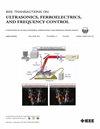Waveform-Specific Performance of Deep Learning-Based Super-Resolution for Ultrasound Contrast Imaging
IF 3
2区 工程技术
Q1 ACOUSTICS
IEEE transactions on ultrasonics, ferroelectrics, and frequency control
Pub Date : 2025-01-30
DOI:10.1109/TUFFC.2025.3537298
引用次数: 0
Abstract
Resolving arterial flows is essential for understanding cardiovascular pathologies, improving diagnosis, and monitoring patient condition. Ultrasound contrast imaging uses microbubbles to enhance the scattering of the blood pool, allowing for real-time visualization of blood flow. Recent developments in vector flow imaging further expand the imaging capabilities of ultrasound by temporally resolving fast arterial flow. The next obstacle to overcome is the lack of spatial resolution. Super-resolved ultrasound images can be obtained by deconvolving radiofrequency (RF) signals before beamforming, breaking the link between resolution and pulse duration. Convolutional neural networks (CNNs) can be trained to locally estimate the deconvolution kernel and consequently super-localize the microbubbles directly within the RF signal. However, microbubble contrast is highly nonlinear, and the potential of CNNs in microbubble localization has not yet been fully exploited. Assessing deep learning-based deconvolution performance for nontrivial imaging pulses is therefore essential for successful translation to a practical setting, where the signal-to-noise ratio (SNR) is limited, and transmission schemes should comply with safety guidelines. In this study, we train CNNs to deconvolve RF signals and localize the microbubbles driven by harmonic pulses, chirps, or delay-encoded pulse trains. Furthermore, we discuss potential hurdles for in vitro and in vivo super-resolution by presenting preliminary experimental results. We find that, whereas the CNNs can accurately localize microbubbles for all pulses, a short imaging pulse offers the best performance in noise-free conditions. However, chirps offer a comparable performance without noise, but they are more robust to noise and outperform all other pulses in low-SNR conditions.基于深度学习的超分辨率超声对比成像的波形特性研究。
分析动脉血流对于了解心血管疾病、改善诊断和监测患者状况至关重要。超声对比成像使用微泡增强血液池的散射,允许实时可视化血液流动。矢量流成像的最新发展进一步扩大了超声的成像能力,通过暂时解决快速动脉血流。下一个需要克服的障碍是缺乏空间分辨率。通过在波束形成之前对射频信号进行反卷积,可以获得超分辨率超声图像,打破了分辨率和脉冲持续时间之间的联系。卷积神经网络(cnn)可以被训练成局部估计反卷积核,从而直接在射频信号中超局部化微泡。然而,微泡对比是高度非线性的,cnn在微泡定位方面的潜力尚未得到充分发挥。因此,评估基于深度学习的非平凡成像脉冲的反卷积性能对于成功转换到实际环境至关重要,在实际环境中,信噪比有限,传输方案应符合安全准则。在本研究中,我们训练cnn对射频信号进行反卷积,并定位由谐波脉冲、啁啾或延迟编码脉冲序列驱动的微泡。此外,我们通过提出初步的实验结果,讨论了体外和体内超分辨率的潜在障碍。我们发现,尽管cnn可以准确定位所有脉冲的微泡,但在无噪声条件下,短成像脉冲的性能最好。然而,啁啾在没有噪声的情况下提供了相当的性能,但对噪声的鲁棒性更强,在低信噪比条件下优于所有其他脉冲。
本文章由计算机程序翻译,如有差异,请以英文原文为准。
求助全文
约1分钟内获得全文
求助全文
来源期刊
CiteScore
7.70
自引率
16.70%
发文量
583
审稿时长
4.5 months
期刊介绍:
IEEE Transactions on Ultrasonics, Ferroelectrics and Frequency Control includes the theory, technology, materials, and applications relating to: (1) the generation, transmission, and detection of ultrasonic waves and related phenomena; (2) medical ultrasound, including hyperthermia, bioeffects, tissue characterization and imaging; (3) ferroelectric, piezoelectric, and piezomagnetic materials, including crystals, polycrystalline solids, films, polymers, and composites; (4) frequency control, timing and time distribution, including crystal oscillators and other means of classical frequency control, and atomic, molecular and laser frequency control standards. Areas of interest range from fundamental studies to the design and/or applications of devices and systems.

 求助内容:
求助内容: 应助结果提醒方式:
应助结果提醒方式:


